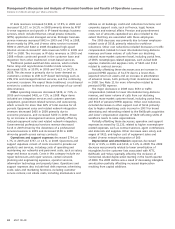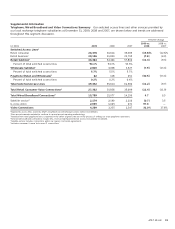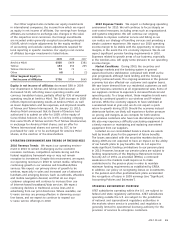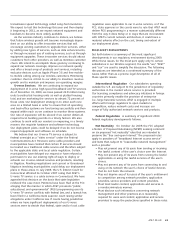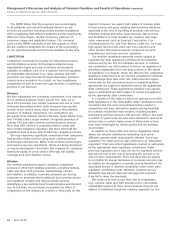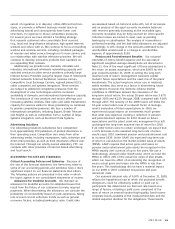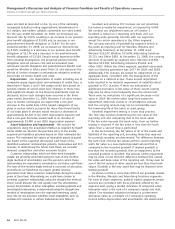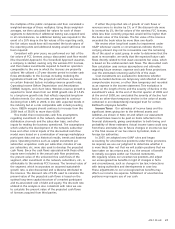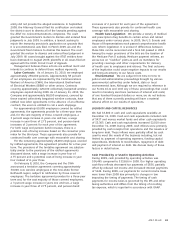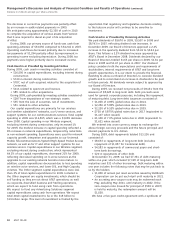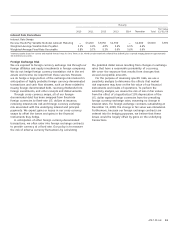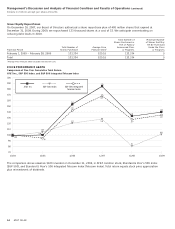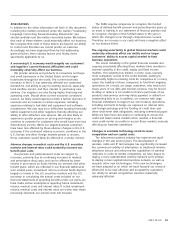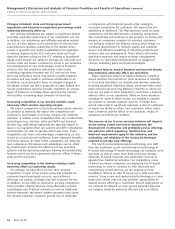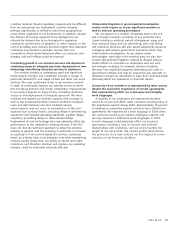AT&T Wireless 2009 Annual Report Download - page 49
Download and view the complete annual report
Please find page 49 of the 2009 AT&T Wireless annual report below. You can navigate through the pages in the report by either clicking on the pages listed below, or by using the keyword search tool below to find specific information within the annual report.
AT&T 09 AR 47
If either the projected rate of growth of cash flows or
revenues were to decline by 1%, or if the discount rate were
to increase by 1%, the fair values of the wireless FCC licenses,
while less than currently projected, would still be higher than
the book value of the licenses. The fair value of the licenses
exceeded the book value by more than one-fourth.
We review other long-lived assets for impairment under
GAAP whenever events or circumstances indicate that the
carrying amount may not be recoverable over the remaining
life of the asset or asset group. In order to determine that the
asset is recoverable, we verify that the expected future cash
flows directly related to that asset exceed its fair value, which
is based on the undiscounted cash flows. The discounted cash
flow calculation uses various assumptions and estimates
regarding future revenue, expense and cash flows projections
over the estimated remaining useful life of the asset.
Cost investments are evaluated to determine whether
mark-to-market declines are temporary and reflected in other
comprehensive income, or other than temporary and recorded
as an expense in the income statement. This evaluation is
based on the length of time and the severity of decline in the
investment’s value. At the end of the first quarter of 2009 and
at the end of 2008, we concluded the severity of decline had
led to an other-than-temporary decline in the value of assets
contained in an independently managed trust for certain
BellSouth employee benefits.
Income Taxes Our estimates of income taxes and the
significant items giving rise to the deferred assets and
liabilities are shown in Note 10 and reflect our assessment
of actual future taxes to be paid on items reflected in the
financial statements, giving consideration to both timing and
probability of these estimates. Actual income taxes could vary
from these estimates due to future changes in income tax law
or the final review of our tax returns by federal, state or
foreign tax authorities.
In 2007, we adopted new GAAP rules and began
accounting for uncertain tax positions under those provisions.
As required, we use our judgment to determine whether it
is more likely than not that we will sustain positions that we
have taken on tax returns and, if so, the amount of benefit
to initially recognize within our financial statements.
We regularly review our uncertain tax positions and adjust
our unrecognized tax benefits in light of changes in facts
and circumstances, such as changes in tax law, interactions
with taxing authorities and developments in case law.
These adjustments to our unrecognized tax benefits may
affect our income tax expense. Settlement of uncertain tax
positions may require use of our cash.
the multiples of the public companies and then calculated a
weighted-average of those multiples. Using those weighted-
averages, we then calculated fair values for each of those
segments to determine if additional testing was required and,
in all circumstances, no additional testing was required. In the
event of a 10% drop in the fair values of the reporting units,
the fair values would have still exceeded the book values of
the reporting units and additional testing would still have not
been required.
Consistent with prior years, we performed our test of the
fair values of FCC licenses using a discounted cash flow model
(the Greenfield Approach). The Greenfield Approach assumes
a company is started, owning only the wireless FCC licenses,
and then makes investments required to build an operation
comparable to the one in which the licenses are presently
utilized. We utilized a 17-year discrete period to isolate cash
flows attributable to the licenses including modeling the
hypothetical build out. The projected cash flows are based
on certain financial factors including revenue growth rates,
Operating Income Before Depreciation and Amortization
(OIBDA) margins, and churn rates. Wireless revenue growth is
expected to trend down from our 2008 growth rate of 15.6%
to a long-term growth rate that reflects expected long-term
inflation trends. Our churn rates are expected to continue
declining from 1.68% in 2008, in line with expected trends in
the industry but at a rate comparable with industry-leading
churn. OIBDA margins should continue to increase from the
2008 level of 38.0% to more than 40.0%.
This model then incorporates cash flow assumptions
regarding investment in the network, development of
distribution channels and the subscriber base, and other
inputs for making the business operational. The assumptions
which underlie the development of the network, subscriber
base and other critical inputs of the discounted cash flow
model were based on a combination of average marketplace
participant data and our historical results, trends and business
plans. Operating metrics such as capital investment per
subscriber, acquisition costs per subscriber, minutes of use
per subscriber, etc. were also used to develop the projected
cash flows. Since the cash flows associated with these other
inputs were included in the annual cash flow projections,
the present value of the unlevered free cash flows of the
segment, after investment in the network, subscribers, etc., is
attributable to the wireless FCC licenses. The terminal value of
the segment, which incorporates an assumed sustainable
growth rate, is also discounted and is likewise attributed to
the licenses. The discount rate of 9.0% used to calculate the
present value of the projected cash flows is based on the
optimal long-term capital structure of a market participant
and its associated cost of debt and equity. The discount rate
utilized in the analysis is also consistent with rates we use
to calculate the present value of the projected cash flows
of licenses acquired from third parties.



